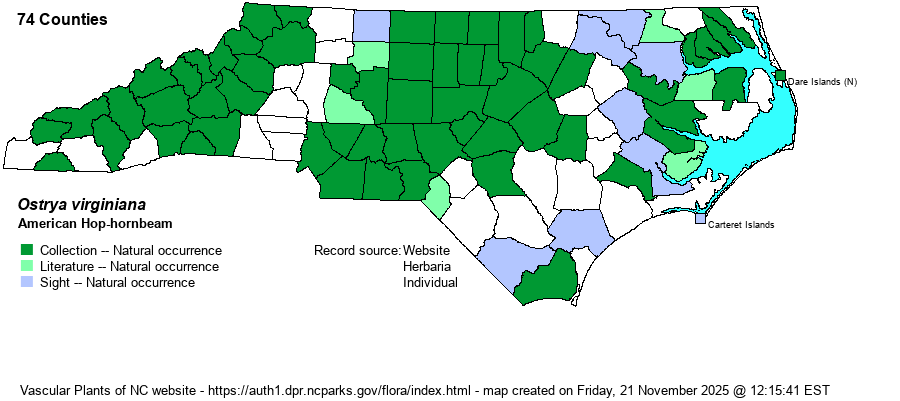| Author | (P. Miller) K. Koch | |
| Distribution | Scattered over nearly all of the state, but primarily found in the mountains and Piedmont, plus the northern and western Coastal Plain. There are scattered records for the southern Coastal Plain, including in coastal counties (at least sight records). There are records for a number of counties both north and south of Albemarle and Pamlico sounds, as well. On the Outer Banks, collected from 3 locations in Dare County and a sight record by John Fussell at Theodore Roosevelt State Natural Area in Carteret County.
This is a species that ranges across southern Canada and the entire eastern U.S., south to central FL and eastern TX.
| |
| Abundance | Fairly common to common over most of the mountains and Piedmont, but a mysterious scarcity of records for the west-central Piedmont. Is this an artifact of collection, or is this a real anomaly? At any rate, it must be considered rare or very infrequent in this zone of the Piedmont. Infrequent in the western Coastal Plain, including the Sandhills, and rare and local elsewhere in the Coastal Plain. | |
| Habitat | This is a species of mesic hardwood forests, favoring slightly acidic soil or circumneutral soil, where it is more numerous. It can occur where somewhat rocky, but not where the soil is sandy. Favored forest types include Mesic Mixed Hardwood Forest, Basic Mesic Forest, Northern Hardwood Forest, and Rich Cove Forest, but it also is found in Basic Oak-Hickory Forest as well. It grows in bottomlands, but it is not really a wetland plant species. |
| Phenology | Flowers in April and May; fruits from August to October. | |
| Identification | This is a small to rarely medium-sized deciduous tree, growing normally to about 40 feet tall. It is usually easily identified by its light brown to gray-brown bark that has long but narrow vertical plates that are loose and shaggy on the ends. The species most similar to it in leaf shape – American Hornbeam (Carpinus caroliniana) – has smooth and tight gray bark that is muscular or fluted into curved “ridges and valleys”. Ostrya has narrowly ovate to elliptic, strongly serrate leaves, with a somewhat tapered tip, growing to about 3 inches long. Ostrya has unique fruit (for our area), they being a tight dangling cluster of pale green leafy bracts, the entire cluster being about 3 inches long. With practice, this should be an easily identified tree in mesic forests, based mainly on its bark characters; it is frequent enough that biologists run into often within a month. | |
| Taxonomic Comments | None
| |
| Other Common Name(s) | Often called just Hop-hornbeam, which is suitable for general usage in the Carolinas; however, there is another Ostrya found from TX westward, and thus the “American” modifier name helps to avoid confusion. Eastern Hop-hornbeam is just as suitable, and it has been used by some references. Ironwood is often used, but this is a confusing name, as many people also refer to Carpinus caroliniana as Ironwood. | |
| State Rank | S5 | |
| Global Rank | G5 | |
| State Status | | |
| US Status | | |
| USACE-agcp | FACU link |
| USACE-emp | FACU link |

